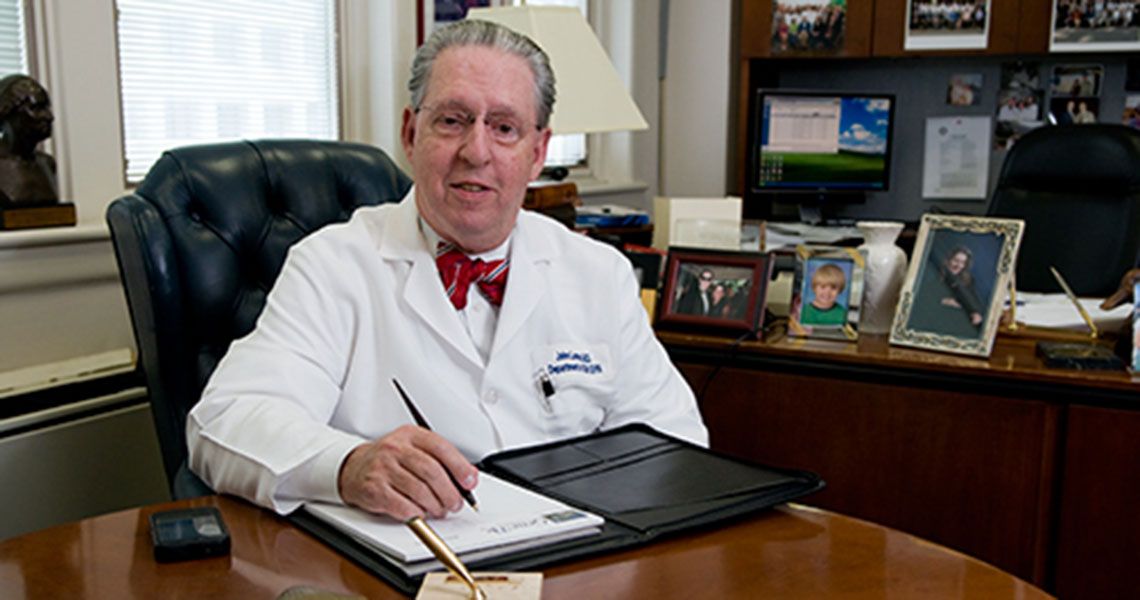It’s a typical Thursday for John Larsen, M.D., chair of the Department of Obstetrics and Gynecology (OBGYN) at GW’s School of Medicine and Health Sciences. He has already performed a repeat cesarean section and tubal ligation, as well as an emergency vaginal delivery of twins for a high-risk patient with ruptured membranes and varicose veins of the cervix. And it’s only 10 a.m.
Even as he approaches his 70th birthday, handling these high-stress situations is what excites Larsen and strengthens his commitment to providing high quality obstetric and gynecological care. His strong performance under pressure shouldn’t come as a surprise, however, considering that Larsen trained as a Green Beret – a member of the United States Army Special Forces – in mountain and winter warfare in the early 1960s.
It was during his third-year rotation in OBGYN at Cornell University Medical College that Larsen recognized his interest in the field. “I originally planned to become a psychiatrist or a neurosurgeon, but neither was meeting my goals for enjoyment,” says Larsen. “OBGYN was a lot of fun and I realized it was something I really wanted to do.”
After 42 years at GW, two of which were spent as interim or permanent department chair, Larsen will step down from his position when a search for the new chair is final. He will continue to see patients regularly and will maintain his tenure, something he values highly.
Larsen’s academic career has been shaped by his early development of a pregnant Rhesus monkey model for Group B Streptococcal infection while working part-time with the National Institutes of Health (NIH) in the mid-to-late 1970s. As a result, he played a role in changing the national standard of care regarding Group B Streptococcus and helped to develop the guidelines for its screening and treatment that are in place today.
He also has been dedicated to prenatal genetic diagnosis, for which he has developed expertise in amniocenteses and chorionic villus sampling. “It has its sad moments when you diagnose that a fetus is abnormal,” Larsen says, “but most of the time you are doing something that gives people who are worried about a problem reassurance that it is not there.”
Early in his career, Larsen was a part of the group that encouraged the federal government to require the fortification of flour with folic acid, which has been shown to decrease the frequency of neural tube defects such as spina bifida and anencephaly when taken by expectant mothers before conception and during early embryo development. Larsen says there was much hand-wringing throughout the lengthy process. Despite the promise that use of folic acid showed some four decades ago, the U.S. Food and Drug Administration did not require fortification of most flour until 1998.
Larsen cites the development of GW’s Medical Faculty Associates into a multi-specialty group practice as one of the most rewarding aspects of his career. “When I started here, it was like a confederation of doctors,” he says. “There was no computerized registration and billing and each doctor and department managed their own affairs as they saw fit.” Larsen soon became interested in the economic aspect of the group practice and served as medical director of GW’s nascent practice plan from 1984 to 1991. “It was incredibly satisfying to see the gradual implementation of a coordinated group practice for the medical faculty,” Larsen says.
A more recent challenge has been to decrease the rate of cesarean delivery, which reached 32.8 percent nationwide in 2010. Midwives were incorporated into GW’s OBGYN department that year; a decision that Larsen says has contributed to early successes in decreasing the rate. The combination of the addition of midwives – who have a cesarean section rate of about 5 percent – and a greater emphasis on the importance of nutrition control and exercise has “started to turn the tide,” according to Larsen.
“No one at GW has been more respected as well as beloved by his patients for a longer period of time than Dr. Larsen,” says Alan Wasserman, M.D., M.A.C.P., Eugene Meyer Professor of Medicine, chair of the Department of Medicine, and president of GW’s Medical Faculty Associates. “Jack is one of if not the hardest working clinical faculty members at GW. He was 30 years ahead of his time with the introduction of genetic testing as a part of pre-natal care and has continued to sleep in the hospital at least one day a week to deliver babies.”
“Although he is stepping down as chairman,” Wasserman says, “we can only hope that he remains a part of our clinical faculty for years to come.”
Before a 2009 accident in which Larsen broke his hip – “repaired right here at GW, thank you very much” – he was an avid golfer who relaxed by hiking and camping. He has since built a farm in eastern North Carolina, where he and his wife raise Black Angus cows and a few horses. “It’s a nice escape,” he says. “But I always enjoy coming back here to do the obstetrical care and the deliveries.” It sounds like Wasserman is in luck.



